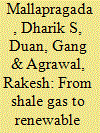|
|
|
Sort Order |
|
|
|
Items / Page
|
|
|
|
|
|
|
| Srl | Item |
| 1 |
ID:
128380


|
|
|
|
|
| Publication |
2014.
|
| Summary/Abstract |
We present an energy roadmap for the US light duty vehicle (LDV) sector that efficiently utilizes natural gas (NG) and transitions to renewable energy and carbon sources as they become economical. We use well-to-wheels (WTW) efficiency to compare alternative NG transportation pathways. If internal combustion engine vehicles (ICEVs) remain prevalent, then compressed natural gas (CNG) is the favored fuel. Among electric powertrains, centralized electricity generation with battery electric vehicle (BEV) is more efficient than on-board generation with fuel-cell vehicles (FCV). Plug-in hybrid electric vehicles (PHEVs) balance driving range against WTW efficiency, and provide flexibility in sourcing electricity from different energy sources. Despite these efficient WTW pathways, supplying NG for the LDV sector is estimated to decrease the lifetime of current US NG reserves to about 60 years. Beyond this period, compressed methane derived from biomass can replace CNG, and utilize the would-be developed CNG infrastructure. The LDV biomass requirement depends on the biomass to methane carbon conversion and battery storage capacity of CNG PHEVs. Converting biomass to methane using solar heat/H2 leads to ~65% lower LDV biomass requirement compared to standalone processes recovering ~30% biomass carbon as methane. The resulting biomass amounts compare favorably with future US biomass supply projections.
|
|
|
|
|
|
|
|
|
|
|
|
|
|
|
|
| 2 |
ID:
112233


|
|
|
|
|
| Publication |
2012.
|
| Summary/Abstract |
We project the well-to-wheels (WTW) and tank-to-wheels (TTW) fossil-energy use, petroleum use, and greenhouse gas (GHG) emissions of the road-transport sector in China up to year 2050 and evaluate the effects of various potential policy options with the fuel economy and environmental impacts (FEEI) model (http://www.feeimodel.org/). The policies evaluated include (1) vehicle fuel-consumption improvements, (2) dieselization, (3) vehicle electrification, and (4) fuel diversification, with plausible policy scenarios. Under the business-as-usual scenario, road transport in China would create 410-520 million metric tons (MMT) of oil-equivalent of TTW oil demand (three to four times the current level), 28-36 billion GJ of WTW energy demand, and 1900-2300 MMT of CO2-equivalent of WTW GHG emissions by 2050. The policies (in the same order as above) are projected to reduce the TTW oil demand by 35%, 10%, 29%, and 44%, and reduce WTW GHG emissions by 34%, 5%, 12%, and 13%, respectively, by 2050. This evaluation reveals that the fuel-consumption improvement policy could achieve greater benefit in reducing oil use, fossil-energy use, and GHG emissions. Implications of each policy option are discussed and the uncertainties associated with the policy scenarios are analyzed.
|
|
|
|
|
|
|
|
|
|
|
|
|
|
|
|
|
|
|
|
|